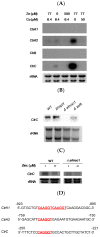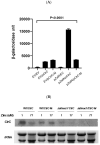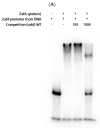The Role of Zinc in Copper Homeostasis of Aspergillus fumigatus
- PMID: 33081273
- PMCID: PMC7593903
- DOI: 10.3390/ijms21207665
The Role of Zinc in Copper Homeostasis of Aspergillus fumigatus
Abstract
Copper is an essential metal ion that performs many physiological functions in living organisms. Deletion of Afmac1, which is a copper-responsive transcriptional activator in A. fumigatus, results in a growth defect on aspergillus minimal medium (AMM). Interestingly, we found that zinc starvation suppressed the growth defect of the Δafmac1 strain on AMM. In addition, the growth defect of the Δafmac1 strain was recovered by copper supplementation or introduction of the CtrC gene into the Δafmac1 strain. However, chelation of copper by addition of BCS to AMM failed to recover the growth defect of the Δafmac1 strain. Through Northern blot analysis, we found that zinc starvation upregulated CtrC and CtrA2, which encode membrane copper transporters. Interestingly, we found that the conserved ZafA binding motif 5'-CAA(G)GGT-3' was present in the upstream region of CtrC and CtrA2 and that mutation of the binding motif led to failure of ZafA binding to the upstream region of CtrC and upregulation of CtrC expression under zinc starvation. Furthermore, the binding activity of ZafA to the upstream region of CtrC was inversely proportional to the zinc concentration, and copper inhibited the binding of ZafA to the upstream region of CtrC under a low zinc concentration. Taken together, these results suggest that ZafA upregulates copper metabolism by binding to the ZafA binding motif in the CtrC promoter region under low zinc concentration, thus regulating copper homeostasis. Furthermore, we found that copper and zinc interact in cells to maintain metal homeostasis.
Keywords: Aspergillus fumigatus; CtrC; ZafA; copper; zinc.
Conflict of interest statement
We declare that we have no competing interests.
Figures








Similar articles
-
Functional characterization of the copper transcription factor AfMac1 from Aspergillus fumigatus.Biochem J. 2017 Jul 3;474(14):2365-2378. doi: 10.1042/BCJ20170191. Biochem J. 2017. PMID: 28515264
-
Identification of high-affinity copper transporters in Aspergillus fumigatus.Fungal Genet Biol. 2014 Dec;73:29-38. doi: 10.1016/j.fgb.2014.09.008. Epub 2014 Oct 2. Fungal Genet Biol. 2014. PMID: 25281782
-
Cu-sensing transcription factor Mac1 coordinates with the Ctr transporter family to regulate Cu acquisition and virulence in Aspergillus fumigatus.Fungal Genet Biol. 2017 Oct;107:31-43. doi: 10.1016/j.fgb.2017.08.003. Epub 2017 Aug 10. Fungal Genet Biol. 2017. PMID: 28803907
-
Zinc acquisition: a key aspect in Aspergillus fumigatus virulence.Mycopathologia. 2014 Dec;178(5-6):379-85. doi: 10.1007/s11046-014-9764-2. Epub 2014 Jun 20. Mycopathologia. 2014. PMID: 24947168 Review.
-
Copper Utilization, Regulation, and Acquisition by Aspergillus fumigatus.Int J Mol Sci. 2019 Apr 23;20(8):1980. doi: 10.3390/ijms20081980. Int J Mol Sci. 2019. PMID: 31018527 Free PMC article. Review.
Cited by
-
Mechanism of Zn2+ regulation of cellulase production in Trichoderma reesei Rut-C30.Biotechnol Biofuels Bioprod. 2023 Apr 28;16(1):73. doi: 10.1186/s13068-023-02323-1. Biotechnol Biofuels Bioprod. 2023. PMID: 37118821 Free PMC article.
-
An Introduction to the Influence of Nutritional Factors on the Pathogenesis of Opportunist Fungal Pathogens in Humans.Pathogens. 2025 Mar 31;14(4):335. doi: 10.3390/pathogens14040335. Pathogens. 2025. PMID: 40333109 Free PMC article. Review.
-
Insights into copper sensing and tolerance in Pneumocystis species.Front Microbiol. 2024 May 15;15:1383737. doi: 10.3389/fmicb.2024.1383737. eCollection 2024. Front Microbiol. 2024. PMID: 38812685 Free PMC article.
-
Functional characterization of genes encoding cadmium pumping P1B-type ATPases in Aspergillus fumigatus and Aspergillus nidulans.Microbiol Spectr. 2023 Sep 7;11(5):e0028323. doi: 10.1128/spectrum.00283-23. Online ahead of print. Microbiol Spectr. 2023. PMID: 37676031 Free PMC article.
References
-
- Porcheron G., Garénaux A., Proulx J., Sabri M., Dozois C.M. Iron, copper, zinc, and manganese transport and regulation in pathogenic Enterobacteria: Correlations between strains, site of infection and the relative importance of the different metal transport systems for virulence. Front. Cell. Infect. Microbiol. 2013 doi: 10.3389/fcimb.2013.00090. - DOI - PMC - PubMed
MeSH terms
Substances
Grants and funding
LinkOut - more resources
Full Text Sources
Miscellaneous

